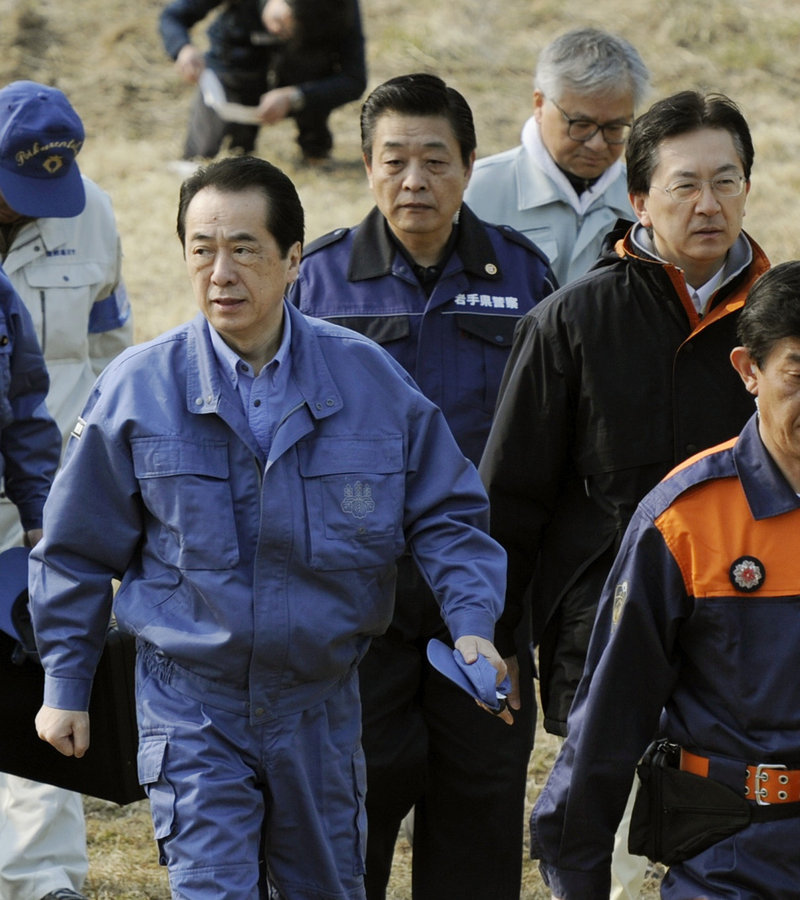SENDAI, Japan – Japan’s prime minister viewed the extensive damage in the northeast for the first time today as troops trolled the decimated coastline in an all-out search for any remaining bodies swept out to sea by a tsunami three weeks ago.
More than 16,000 people are still missing after the disaster, which officials fear may have killed 25,000 people. The magnitude-9.0 earthquake and ensuing tsunami also ravaged a nuclear plant.
Prime Minister Naoto Kan went to the Fukushima Dai-ichi complex immediately after the wave knocked out cooling systems, leaving workers unable to control overheating reactors and allowing radiation to seep out.
But today marked his first visit to some of the dozens of villages, towns and cities wiped out in the March 11 disaster. Kan stopped first in Rikuzentakata — a town of about 20,000 people that was flattened by the torrent of water.
A day earlier, he sounded a resolute note, promising to win the battle against the overheating nuclear plant.
On the outskirts of Sendai, near the Japanese military’s Kasuminome air base, a constant stream of helicopters roared overhead throughout Friday afternoon, shuttling to and from the more remote coastal regions. Planes and boats were dispatched from other bases near the city.
More than 25,000 troops, 120 helicopters and 65 ships from the Japanese and U.S. militaries will continue searching through Sunday. So far, more than 11,700 deaths have been confirmed.
“Unfortunately, we’ve come across remains over the scope of our mission, so it may be more likely than you think” to find bodies at sea so long after the disaster, said U.S. Navy Lt. Anthony Falvo.
Some bodies may have sunk and just now are resurfacing. Others may never be found. After the 2004 Indian Ocean tsunami, 37,000 of the 164,000 people who died in Indonesia simply disappeared, their bodies presumably washed out to sea.
The Japanese military stopped short of saying the search would end after Sunday, but public affairs official Yoshiyuki Kotake said activities will be limited. The search includes places that were submerged or remain underwater, along with the mouths of major rivers and the ocean as far as 12 miles from shore.
Police officers have also been searching for bodies in decimated towns inland, but in some cases their efforts have been complicated or even stymied by dangerous levels of radiation from the nuclear plant, which is 140 miles northeast of Tokyo.
People who live within 12 miles of the plant have been forced to leave, though residents are growing increasingly frustrated and have been sneaking back to check on their homes. Government officials warned Friday that there were no plans to lift the evacuation order anytime soon.
Radiation concerns have rattled the Japanese public. Three weeks after the disaster in one of the world’s most connected countries, 260,000 households still have no running water and 170,000 have no electricity.
Officials at the International Atomic Energy Agency in Vienna said Friday that the nuclear watchdog was sending two reactor specialists to Japan to get firsthand information. They’ll meet experts in Tokyo and may go to the Fukushima site.
Send questions/comments to the editors.



Success. Please wait for the page to reload. If the page does not reload within 5 seconds, please refresh the page.
Enter your email and password to access comments.
Hi, to comment on stories you must . This profile is in addition to your subscription and website login.
Already have a commenting profile? .
Invalid username/password.
Please check your email to confirm and complete your registration.
Only subscribers are eligible to post comments. Please subscribe or login first for digital access. Here’s why.
Use the form below to reset your password. When you've submitted your account email, we will send an email with a reset code.